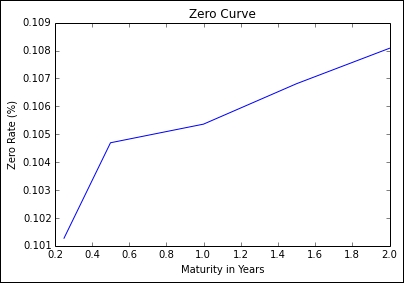Short-term spot rates can be derived directly from various short-term securities, such as zero-coupon bonds, T-bills, notes, and Eurodollar deposits. However, longer-term spot rates are typically derived from the prices of long-term bonds through a bootstrapping process, taking into account the spot rates of maturities corresponding to the coupon payment date. After obtaining short-term and long-term spot rates, the yield curve can then be constructed.
Let's illustrate the bootstrapping of the yield curve with an example. The following table shows a list of bonds with different maturities and prices:
|
Bond face value in Dollars |
Time to maturity in years |
Annual coupon in Dollars |
Bond cash price in Dollars |
|---|---|---|---|
|
100 |
0.25 |
0 |
97.50 |
|
100 |
0.50 |
0 |
94.90 |
|
100 |
1.00 |
0 |
90.00 |
|
100 |
1.50 |
8 |
96.00 |
|
100 |
2.00 |
12 |
101.60 |
An investor of a 3-month zero-coupon bond today at $97.50 would earn an interest of $2.50. The 3-month spot rate can be calculated as follows:

Thus, the 3-month zero rate is 10.127 percent with continuous compounding. The spot rates of the zero-coupon bonds are computed in the following table:
|
Time to maturity in years |
Spot rate (in percent) |
|---|---|
|
0.25 |
10.127 |
|
0.50 |
10.469 |
|
1.00 |
10.536 |
Using these spot rates, we can now price the 1.5-year bond as:
To solve for y, the spot rate for the 1.5-year bond and 2-year bond is 10.681 percent and 10.808 percent respectively.
The following code is an implementation of bootstrapping a yield curve in Python. Save this code to BootstrapYieldCurve.py:
""" Bootstrapping the yield curve """
import math
class BootstrapYieldCurve():
def __init__(self):
self.zero_rates = dict() # Map each T to a zero rate
self.instruments = dict() # Map each T to an instrument
def add_instrument(self, par, T, coup, price,
compounding_freq=2):
""" Save instrument info by maturity """
self.instruments[T] = (par, coup, price, compounding_freq)
def get_zero_rates(self):
""" Calculate a list of available zero rates """
self.__bootstrap_zero_coupons__()
self.__get_bond_spot_rates__()
return [self.zero_rates[T] for T in self.get_maturities()]
def get_maturities(self):
""" Return sorted maturities from added instruments. """
return sorted(self.instruments.keys())
def __bootstrap_zero_coupons__(self):
""" Get zero rates from zero coupon bonds """
for T in self.instruments.iterkeys():
(par, coup, price, freq) = self.instruments[T]
if coup == 0:
self.zero_rates[T] =
self.zero_coupon_spot_rate(par, price, T)
def __get_bond_spot_rates__(self):
""" Get spot rates for every marurity available """
for T in self.get_maturities():
instrument = self.instruments[T]
(par, coup, price, freq) = instrument
if coup != 0:
self.zero_rates[T] =
self.__calculate_bond_spot_rate__(
T, instrument)
def __calculate_bond_spot_rate__(self, T, instrument):
""" Get spot rate of a bond by bootstrapping """
try:
(par, coup, price, freq) = instrument
periods = T * freq # Number of coupon payments
value = price
per_coupon = coup / freq # Coupon per period
for i in range(int(periods)-1):
t = (i+1)/float(freq)
spot_rate = self.zero_rates[t]
discounted_coupon = per_coupon *
math.exp(-spot_rate*t)
value -= discounted_coupon
# Derive spot rate for a particular maturity
last_period = int(periods)/float(freq)
spot_rate = -math.log(value /
(par+per_coupon))/last_period
return spot_rate
except:
print "Error: spot rate not found for T=%s" % t
def zero_coupon_spot_rate(self, par, price, T):
""" Get zero rate of a zero coupon bond """
spot_rate = math.log(par/price)/T
return spot_rateWe can instantiate the BootstrapYieldCurve class, and add each bond's information from the preceding table:
>>> from BootstrapYieldCurve import BootstrapYieldCurve >>> yield_curve = BootstrapYieldCurve() >>> yield_curve.add_instrument(100, 0.25, 0., 97.5) >>> yield_curve.add_instrument(100, 0.5, 0., 94.9) >>> yield_curve.add_instrument(100, 1.0, 0., 90.) >>> yield_curve.add_instrument(100, 1.5, 8, 96., 2) >>> yield_curve.add_instrument(100, 2., 12, 101.6, 2) >>> y = yield_curve.get_zero_rates() >>> x = yield_curve.get_maturities()
Calling the get_zero_rates method in the class returns a list of spot rates in the same order as the maturities, which are stored in the y and x variables respectively. When we plot x and y on a graph, we get the following output:
>>> import matplotlib.pyplot as plt >>> plt.plot(x, y) >>> plt.title("Zero Curve") >>> plt.ylabel("Zero Rate (%)") >>> plt.xlabel("Maturity in Years") >>> plt.show()

In a normal yield curve environment, where the interest rates increase as the maturities increase, we can obtain an upward-sloping yield curve.
